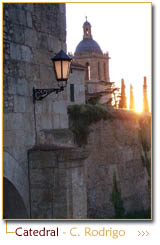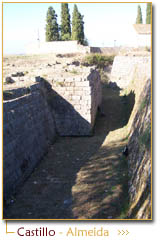|
 To
discover the origins of Ciudad
Rodrigo, we must first travel back
to the Lower Palaeolithic,
although the most spectacular
remains correspond to the Upper
Palaeolithic, namely, the cave
complex of Siega Verde (10
km to the north-west of the city),
where in addition to numerous and
well-preserved drawings, we can
find megalithic structures, such
as dolmens.
To
discover the origins of Ciudad
Rodrigo, we must first travel back
to the Lower Palaeolithic,
although the most spectacular
remains correspond to the Upper
Palaeolithic, namely, the cave
complex of Siega Verde (10
km to the north-west of the city),
where in addition to numerous and
well-preserved drawings, we can
find megalithic structures, such
as dolmens.
 |
 The
site at Giera
provides vestiges of the Copper
Age and Bronze Age,
with the most
representative piece being
the idol of Ciudad
Rodrigo. Regarding the Iron
Age, we have a
magnificent granite boar,
which now stands in the
square, the Plaza del
Castillo.
The
site at Giera
provides vestiges of the Copper
Age and Bronze Age,
with the most
representative piece being
the idol of Ciudad
Rodrigo. Regarding the Iron
Age, we have a
magnificent granite boar,
which now stands in the
square, the Plaza del
Castillo.
 As
from the Second Iron
Age, it fell to the
Vetones to settle on the
land that is now the site
of our city.
As
from the Second Iron
Age, it fell to the
Vetones to settle on the
land that is now the site
of our city.
 The
2nd century
BC witnessed the first
contact between the Vetones
and the Romans,
which eventually led to
Roman domination. This
territory became
integrated within the
province of Lusitania.
The Three Columns
that form the emblem of
Ciudad Rodrigo date from
this time, as do several
inscriptions that still
survive to this day. The
2nd century
BC witnessed the first
contact between the Vetones
and the Romans,
which eventually led to
Roman domination. This
territory became
integrated within the
province of Lusitania.
The Three Columns
that form the emblem of
Ciudad Rodrigo date from
this time, as do several
inscriptions that still
survive to this day.
|
|
 Few
data are available on the
High Medieval period.
Few
data are available on the
High Medieval period.
 As
of 1161, the city
underwent major political
and ecclesiastical
expansion, thanks to King
Ferdinand II of Leon,
whose intention was to
create a stronghold for
defence against possible
skirmishes with the
Portuguese and Almohads.
With this in mind, he
introduced a repopulation
policy: he gave the city
its charter, defended it
with ramparts and elevated
it to the status of
bishopric.
As
of 1161, the city
underwent major political
and ecclesiastical
expansion, thanks to King
Ferdinand II of Leon,
whose intention was to
create a stronghold for
defence against possible
skirmishes with the
Portuguese and Almohads.
With this in mind, he
introduced a repopulation
policy: he gave the city
its charter, defended it
with ramparts and elevated
it to the status of
bishopric.
 Conflict
was rife during the Middle
Ages, given the city’s
location as a border town.
Thus, Ciudad Rodrigo
featured in the civil war
waged by Peter I
and Henry II of
Trastamara.
Conflict
was rife during the Middle
Ages, given the city’s
location as a border town.
Thus, Ciudad Rodrigo
featured in the civil war
waged by Peter I
and Henry II of
Trastamara.
 The
city was again the scene
of conflict at the time of
the War of Secession
from the Crown of Castile
between Isabel, the
Catholic Queen, and Juana
la Beltraneja. Given
that the city ended up
siding with Isabella’s
The
city was again the scene
of conflict at the time of
the War of Secession
from the Crown of Castile
between Isabel, the
Catholic Queen, and Juana
la Beltraneja. Given
that the city ended up
siding with Isabella’s
cause
the Catholic
Monarchs
granted it
the
privilege of
holding a tax-free
market
every
Tuesday.
 Following
the first
expulsion of
the Jews in 1492,
Ciudad
Rodrigo
became one
of the more
affluent
places
between
Castile and
Portugal. It
subsequently
became home
to a large
population
of converted
Jews, or conversos,
as some
returned to
be baptised.
Following
the first
expulsion of
the Jews in 1492,
Ciudad
Rodrigo
became one
of the more
affluent
places
between
Castile and
Portugal. It
subsequently
became home
to a large
population
of converted
Jews, or conversos,
as some
returned to
be baptised.
 Our
city
underwent
its golden
age in the 16th
century,
when there
was a great
deal of
activity
thanks to
political
stability
and economic
resurgence.
Our
city
underwent
its golden
age in the 16th
century,
when there
was a great
deal of
activity
thanks to
political
stability
and economic
resurgence.
 A
plethora of
conflicts in
the 17th century
led to a
sharp
decline.
These
involved the
Portuguese
War of
Independence
(1640-1668)
and the War
of
Succession
to the
Spanish
Throne
(1700-1714),
during which
sacking,
pillaging
and sieges
undermined
the economic
wealth and
population
of the city
and its
surrounding
district.
A
plethora of
conflicts in
the 17th century
led to a
sharp
decline.
These
involved the
Portuguese
War of
Independence
(1640-1668)
and the War
of
Succession
to the
Spanish
Throne
(1700-1714),
during which
sacking,
pillaging
and sieges
undermined
the economic
wealth and
population
of the city
and its
surrounding
district. |
 |
 Yet
the hardest
times for
Ciudad
Rodrigo
occurred
during the Peninsular
War
(1808-1812).
Its frontier
setting
meant that
it was twice
placed under
siege: by
the French
in 1810 and
by the
British in
1812, with
extensive
damage being
caused. In
1812, the
future Duke
of
Wellington
retook the
city, and in
recognition
of this feat
the Spanish
Crown
honoured him
with the
title of
Duke of
Ciudad
Rodrigo.
Yet
the hardest
times for
Ciudad
Rodrigo
occurred
during the Peninsular
War
(1808-1812).
Its frontier
setting
meant that
it was twice
placed under
siege: by
the French
in 1810 and
by the
British in
1812, with
extensive
damage being
caused. In
1812, the
future Duke
of
Wellington
retook the
city, and in
recognition
of this feat
the Spanish
Crown
honoured him
with the
title of
Duke of
Ciudad
Rodrigo.
 Between
1851
and 1951,
there was no
Bishopric in
our city,
which fell
under the
jurisdiction
of the
Dioceses of
Salamanca.
Between
1851
and 1951,
there was no
Bishopric in
our city,
which fell
under the
jurisdiction
of the
Dioceses of
Salamanca.
 The
outbreak of
hostilities
in 1936,
with the
start of the
Spanish
Civil War,
again led to
dramatic
circumstances,
which
concluded
with the end
of the
conflict,
three years
later.
The
outbreak of
hostilities
in 1936,
with the
start of the
Spanish
Civil War,
again led to
dramatic
circumstances,
which
concluded
with the end
of the
conflict,
three years
later.
 In
the 1960s,
Ciudad
Rodrigo and
its district
experienced
a sharp
decline in
population,
due to the
rise in
emigration
abroad and
to other
more
industrialised
parts of
Spain.
In
the 1960s,
Ciudad
Rodrigo and
its district
experienced
a sharp
decline in
population,
due to the
rise in
emigration
abroad and
to other
more
industrialised
parts of
Spain. |
|
|
 |
|